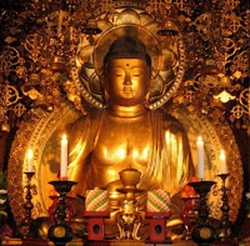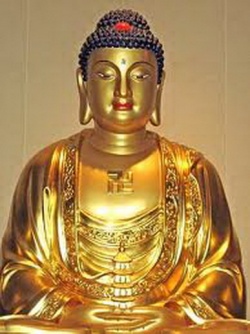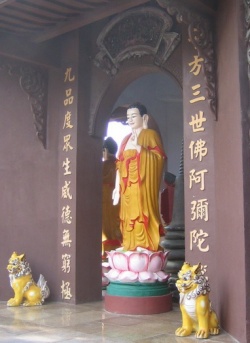Difference between revisions of "Infinite Life Sutra 01"
| Line 46: | Line 46: | ||
[[File:IMG 2882.JPG|thumb|250px|]] | [[File:IMG 2882.JPG|thumb|250px|]] | ||
| − | Therefore, the name Amitabha Buddha is the key guiding principle. When we master this guiding principle, we will thoroughly understand the entire [[Dharma]], all the sutras, and all [[ | + | Therefore, the name Amitabha Buddha is the key guiding principle. When we master this guiding principle, we will thoroughly understand the entire [[Dharma]], all the sutras, and all [[the Dharma]] doors. |
“Steadfastly dwelt in” means focusing one’s mind on Amituofo. For a true practitioner who wants to have a fast, assured success in his practice in this lifetime, the Buddha-name is all he needs. One chants and reads the sutras to understand the truth. Once confidence is established upon one's understanding of the principles and the truth, one will naturally let go of everything else. | “Steadfastly dwelt in” means focusing one’s mind on Amituofo. For a true practitioner who wants to have a fast, assured success in his practice in this lifetime, the Buddha-name is all he needs. One chants and reads the sutras to understand the truth. Once confidence is established upon one's understanding of the principles and the truth, one will naturally let go of everything else. | ||
Revision as of 10:14, 18 June 2013
Excerpt One
All followed and cultivated the virtues of Samantabhadra Bodhisattva,were replete with infinite vows and practices,and steadfastly dwelt in the virtues and merits of all dharmas.
This first excerpt points out the objective of the Pure land school.
A well-accomplished practitioner added “The Chapter of the Vows and Practices of Samantabhadra Bodhisattva” to the three Pure land sutras and called them the four Pure land sutras. He did so based on the above excerpt. These words tell us that the beings in the Western Pure land—in the four lands and from the lowest grade to the highest of the nine Rebirth grades—all cultivated the virtues of Samantabhadra. It is not surprising then that in the Lotus Treasury assembly, all forty-one levels of Dharma-body Bodhisattvas follow the example of Samantabhadra Bodhisattva—they mindfully chant the Buddha-name and seek Rebirth in the Land of Ultimate Bliss.
It is also stated in the Mahayana sutras that if a Bodhisattva does not cultivate the practice of Samantabhadra, he will not be able to perfectly attain Buddhahood. “Perfect” refers to the attainment of perfect Buddhahood, which is the Buddhahood of the Perfect Teaching mentioned in the Tiantai school.
“Vows” in “infinite vows and practices” means aspiration. “Practices” means implementation, to carry out. When we condense “infinite vows and practices,” we have the Four Great Vows. When expanded, the Four Great Vows become infinite vows and practices.
Samantabhadra Bodhisattva uses the Ten Great Vows as the key guiding principle for infinite vows and practices. The practice of Samantabhadra differs from other methods, for the mind of Samantabhadra Bodhisattva is truly pure and impartial, without any discrimination or attachment. He treats everyone in the entire Dharma Realm equally.
The first of the Ten Great Vows is “to respect all Buddhas.” “All Buddhas” encompasses all beings. The Avatamsaka Sutra and the Sutra of Perfect Enlightenment both say “All beings are Buddhas in nature.” Therefore, “to respect all Buddhas” is to equally respect the past Buddhas, the present Buddhas, and the future Buddhas (all beings).
It is stated in the sutras that all Sentient beings have Buddha-nature. It is called Dharma-nature in non-Sentient beings. Buddha-nature and Dharma-nature refer to the same nature. This is why the Avatamsaka Sutra says “Sentient and non-Sentient beings all have the same Buddha-Wisdom.”
We should be as respectful to non-Sentient beings as to Buddhas. For example, tables and chairs are non-Sentient beings. Our respect to them should be the same as that to Buddhas, without any difference. This is the practice of Samantabhadra. When we see tables and chairs, we put them in their proper places and keep them clean. This is showing our respect to them. The respect in our hearts is exactly the same, though there are differences in how we express that respect [to sentient beings and to non-sentient beings]. Practicing respect for all Buddhas starts from this point [the impartial respect for all beings].
Everything should start with respect—not just when we are learning the supreme Buddha-Dharma. “Single-minded respect”—we often read these words in the repentance section that appears in the Buddhist practice book. Single-mindedness is the practice of Samantabhadra. It signifies impartiality. Single-mindedness is maintaining the same mind whether we encounter Buddhas, people, animals, or tables and chairs. With two minds, differences and discrimination arise. Therefore, with two minds or three minds, we are not quite respectful and not following the practice of Samantabhadra. We must clearly understand this before we know how to learn.
The second vow is “to praise Tathagata.” What is the difference between “Tathagata” and “Buddha”? From the aspect of form, we say “Buddha.” We should single-mindedly and equally respect all [Buddhas, all beings]. From the aspect of nature, we say "Tathagata." If something accords with the true nature, then it is good and we should praise it. If it does not accord with the true nature, then it is bad. We should be respectful to all but we should not praise bad things or wrongdoers. We should keep our distance [i.e., not learn from them] and continue to be respectful. There should be no difference in our respect.
Sudhana’s visiting fifty-three wise teachers is a very good example of this. Normally, when he visited a wise teacher, he first showed respect and then praised the teacher. But among the fifty-three wise teachers, all of whom he showed respect, there were three he did not praise. The first of the three teachers was a Brahman named Jayosmaya, who symbolized ignorance. The second was a king named Anala, who symbolized anger. The third was a woman named Vasumitra, who symbolized greed. These three teachers symbolized greed, anger, and ignorance. To greed, anger, and ignorance, Sudhana showed respect but did not praise.
From this we understand that when one praises, one praises the good, not the bad. But when one pays respect, one does not differentiate between good and bad. There is a significant difference between praising and paying respect. We must realize this.
I will not go into detail about the Ten Great Vows, as I have done so elsewhere.
The ten vows of Samantabhadra Bodhisattva sum up infinite practices and vows. But the forty-eight vows of Amitabha Buddha are more detailed than the Ten Great Vows. However, the most important of all is to be “replete.” Are we “replete”? If we have belief and practice but no vows,[1] then we will not be able to attain Rebirth in the Western Pure land. If we truly want to attain Rebirth in the Western Pure land in this lifetime, we must chant the forty-eight vows in the Infinite Life Sutra as our morning cultivation every day. By chanting them every day and constantly learning them, we make the forty-eight vows our causal vows. Then we are “replete” with the vows. Amitabha Buddha's forty-eight vows are infinite practices and vows, and encompass the Ten Great Vows of Samantabhadra Bodhisattva and the Four Great Vows.
“All . . . steadfastly dwelt in the virtues and merits of all dharmas.” “The virtues and merits of all dharmas” is “Namo Amituofo.” During the Sui and Tang dynasties, eminent monks compared the sutras from the Buddha’s forty-nine years of teaching to determine which was number one. They agreed that the Avatamsaka Sutra was number one. It was the king of the sutras and the fundamental Dharma-wheel. Next, they made a comparison between the Avatamsaka Sutra and the Infinite Life Sutra and concluded that the Infinite Life Sutra was number one. Why? At the end of the Avatamsaka Sutra, Samantabhadra taught the Ten Great Vows and guided all beings to the Western Pure land and with this the Sutra was perfectly completed. On the other hand, the Infinite Life Sutra, from the beginning to the end, describes the Western Pure land. Hence, the Infinite Life Sutra sums up and fulfills the final goal of the Avatamsaka Sutra. The Infinite Life Sutra is thus number one of all number ones.
Mr. Xia Lianju divided the Infinite Life Sutra into forty-eight chapters. Which chapter is number one? The chapter with the forty-eight vows. The forty-eight vows were spoken by Amitabha Buddha himself and is the most important part of the entire Sutra.
Of the forty-eight vows, which vow is number one? The eminent monks said that the eighteenth vow is number one. Why did they say so? The eighteenth vow says that through mindful chanting of Amituofo ten times at the end of one’s life one can attain Rebirth in the Western Pure land. This illustrates the inconceivability of the merit of the name of Amitabha Buddha. This is why the name of Amitabha Buddha is “the virtues and merits of all dharmas.”
When the name of Amitabha Buddha is elaborated on, we have the forty-eight vows. When the forty-eight vows are elaborated on, we have the Infinite Life Sutra. When the Infinite Life Sutra is elaborated on, we have the Avatamsaka Sutra. When the Avatamsaka Sutra is elaborated on, we have all the sutras from Sakyamuni Buddha’s forty-nine years of teaching.
Therefore, the name Amitabha Buddha is the key guiding principle. When we master this guiding principle, we will thoroughly understand the entire Dharma, all the sutras, and all the Dharma doors.
“Steadfastly dwelt in” means focusing one’s mind on Amituofo. For a true practitioner who wants to have a fast, assured success in his practice in this lifetime, the Buddha-name is all he needs. One chants and reads the sutras to understand the truth. Once confidence is established upon one's understanding of the principles and the truth, one will naturally let go of everything else.
Not only Sakyamuni Buddha, but all Buddhas use this method as the foremost method to teach all beings. The Pure land method is hard to believe but easy to practice. Only when one has great good fortune and great Wisdom will one be able to believe this method. In the Theravada tradition for example, Sariputra[2] is foremost in Wisdom. In the Mahayana tradition, Manjusri is foremost in Wisdom. Therefore, if one is not superior in Wisdom, one cannot believe this method.
Let’s think about this. Not only can our Wisdom not compare with that of Manjusri Bodhisattva, it cannot even compare with that of Elder Sariputra of the Theravada tradition. But when we hear the Pure land method, we are immediately delighted, believe and accept it, and are willing to learn and practice it. From this viewpoint, we are not inferior to Manjusri Bodhisattva. He chose this method, so have we. His choice was a wise one, so is ours.
“Steadfastly dwelt” means our minds will no longer waver once we understand the principles and the phenomena of the truth, after which our minds will truly settle in “Namo Amituofo.” This [Namo Amituofo] is “the virtues and merits of all dharmas.”[3]
[1] Belief, vow, and practice are the three requisites for being reborn in the Pure land.—Trans.
[2] Both the Elder Sariputra and Manjusri Bodhisattva are listed in the assemblies listening to the Amitabha Sutra and the Infinite Life Sutra.
[3] These are the virtues and merits of Buddhahood.




